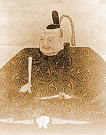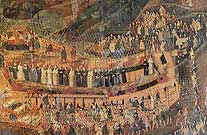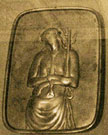- HOME |
- NEWS |
- HISTORY |
- CHURCH |
- WHO ARE WE?
"Laudate" English Page
History of the Japanese Catholic Church
5.CHRISTIAN PERSECUTION
National isolation and prohibition of Christian religion

In general, one might have an idea of *1 national isolation and restriction of harbor for commerce in Edo era . However, during the government by Ieyasu Tokugawa, the commercial harbor was not restricted clearly.
After the death of Ieyasu, in 1616 (year Genna 2) the second feudal lord Hidetada, gave an order for prohibition of Christian religion and restricted the coming of the European ship to the port of Nagasaki and Hirato. And before these, there was the prohibition of religion.
After the using restriction of those two ports, Hidetada continued to realize the suppression of Christian religion. The following year, 1617, he defended people of Nagasaki to welcome missionaries in their home, and to execute missionaries who were hiding.
In 1619, when Hidetada visited Fushimi, he ordered the execution of all Christians who were in prison, and all those who had any contact with them. In Shichijo Kawara
in Kyoto, 52 faithfuls including small children were burnt to death.
In this kind of severe situation, Pope Paul 5th sent to the church of Japan, a word of encouragement and the grace of Jubileum (Holy year, or amnesty year made official by the Pope). To this favor, Christian people sent to the Pope a letter of gratitude, and promised to be faithful to Christ and to the church. This letter has been kept until now in the Vatican library.
Another incident made the situation of the church of Japan even worse.
Incident of Jochin Hirayama.
In 1620, (year Genna 6 ) an English-Dutch ship captured a *3 “Shuin Sen” (commercial ship with authorization from the government marked with a red sign) and came into the port of Hirato. The reason why they captured this ship was that there were on board Europeans who were believed to be missionaries. Father Sniga from the Augustino congregation and the Dominican Father Flores, tried to come into Japan as merchants.
As all the products which were on board of this Shuin Sen, could belong to them, English commercial office in Hirato reported this happening to the feudal government.
Governor of Hirato, Takanobu Matsuura, together with the government office of Nagasaki and Kenroku Hasegawa, made a very strict examination of Sniga and Flores. But on the contrary, the government office of Nagasaki has been accused by Sniga and Jochin Hirayama, captain of the ship, *2, of commiting piracy.. This made the situation difficult and it took a long time to resolve.
After two years, Sniga and Flores had to confess, and together with *2 Jochin Hirayama, they had been burnt to death. And other 12 crew members of *3 Shuin Sen were sentenced to decapitation.
Since this incident, distrust of the government towards Christian religion got stronger and that resulted in persecution.
Martyrdom of Nagasaki

In August 1622, (year Genna 8 ) Hidetada gave an order to execute all missionaries and Christians who were in prison of Suzuta and Nagasaki. 55 Christians of the church of Nagasaki got executed. This was the great martyrdom of the year Genna.
Great martyrdom of Edo.
In 1623, when the third feudal lord Iemitsu Tokugawa had the political power, many were executed in Edo. In December, 50 people including the Jesuit Father Angelis, and Mondo Hara had been killed and 20 days later, 37 women and children had been executed in Tuji-no-Fuda. .
It has been told that around this time, more than 300 people had been captured and 400 to 500 died in martyrdom.
Since this great martyrdom, the Christian suppression had been fortified.
“Fumie” (forced trampling of Christian images)

In the Edo era, when Christian religion had been forbidden, in order to prove that one is not Christian, “Fumie” (trampling on the picture) had been used.
One treaded the picture of Jesus or Mary for instance.
In the beginning, the trampling board was some medals and statues confiscated from Christians but when those got broken or damaged, and when this became a system,
governmental office of Nagasaki had them made of brass.
Some of those are still kept in Tokyo National Museum.
This system of treading pictures started in Nagasaki in forcing to leave the Christian religion, and as its proof from 1628. This has been executed in various places in Kyushu, where there were many Christians. However, it was only in Kyushu that this became a system. In other places outside Kyushu, it was done when there were
incursions of missionaries, or some *4 hiding Christians disclosed.
In the beginning, this was only done to *5“korobi Christians” who left their religion, but later it was used to disclose Christians among all people systematically.
As everyone has been asked to do this, it became almost like an annual event. During the New Year holidays, Nagasaki became a place where courtesans competed their beautiful kimono.
In 1858 (year Ansei 5), *6 this system has been abolished by the American-Japanese treaty of amity.
Annotation.
- *1 National isolation
-
This was the law legislated by Iemitsu Tokugawa, with regard to foreign relations. It started with prohibition of Christianity and little by little, extended to prohibition of Japanese going abroad, and returning of those who lived abroad; to regulation of foreign commercial ship, expulsion of mixed blood children between Japanese and Portuguese, and prohibition of Portuguese ship to come to Japan. All commerce between Portugal has been given up because of the closeness with the Society of Jesus. Prohibition of all missionaries to come to Japan has also been planned.
This had been going on for 226 years, until the treaty of amity in 1859 (year Ansei 6 ), between the feudal government Edo and the United States, Netherlands,
Russia, England and France. - *2 Jochin Hirayama ( ? ~1622)
-
Christian merchant born in Sakae. He was baptized in
Kyoto, and his name for the baptism was Dias. - *3 Shuin Sen
-
From the period of feudal government Edo, all ships going over sea had been given a certificate called red seal certificate. This showed the destination and the nationality.
Between 1601 (year Keicho 6) and 1635 (year Kanei 12), until all Japanese ships were forbidden to sail overseas, Japan exported silver, copper, iron, sulphur, pottery, porcelain and sword, and imported raw silk, silk fabric, deer and shark leather, lead and sugar. - *4 Hidden Christians
-
From the prohibition of Christianity in 1614 (year Keicho 18) while the control over Christians had been all over the country, some had been registered as Buddhist on the surface but kept the Christian faith. They have formed an underground organization by groups of five, and that was one of the reasons to make the hiding possible.
- *5 “Korobi Christians”
-
The Christians who left their faith. The professionals were called “korobi bateren” (priests). “.Those who left their faith had to write an accepting note to be released, but the whole family, until grand-children had to be registered and be under supervision.
However, it is worth mentioning that despite the fact that they seemed to have left their faith, on the surface, and belonged to Shuumondera, (Buddhist temple where they registered as requested by the government), they continued to transmit their Christian faith until the end of Edo era, 1865, (year Keio 1) to revive the Christian religion once again. - *6 Japanese-American amity and commercial treaty.
-
(Clause 8)
At the Nagasaki governmental office, the Fumie custom has already been abolished.
Copyright (C) 2007-2009 Daughters of St.Paul, Japan. All Rights Reserved.